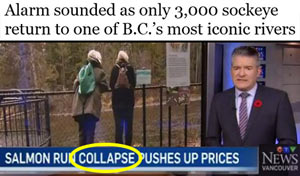
'Worst Ever': Alarm over shocking crash of salmon population in Pacific Northwest — 'Very frightening… Pathetic… Grave… Disastrous… Non-existent” — Official calls for immediate government action — “Something majorly wrong is happening in our oceans'' (VIDEOS)
ENE News
Globe and Mail, Nov 4, 2015: British Columbia’s iconic Adams River salmon run… appears to have collapsed… Jim Cooperman, president of the Shuswap Environmental Action Society, said the spawning beds… are empty this fall… “It’s pretty grim here at the Adams River … it’s quite depressing here really.”… Because the fish mature at four years of age, the runs are on a cycle, which means each one usually reflects the progenitor run that occurred four years before [i.e. 2011]… it is the worst return ever on that cycle; the next lowest year was 1939, when 16,000 fish came back. Mr. Cooperman said the small return represents “a very frightening crash,” and two successive poor years should set off alarm bells…
Salmon Arm Observer, Oct 27, 2015: Sockeye numbers shockingly low… South Thompson sockeye run has been disastrous… No late-run sockeye were observed in upper Adams… Four years ago, late-run salmon were in the millions, sparking hopes of a large return…
CTV, Nov 6, 2015: Alarm sounded after dismal sockeye salmon return to iconic B.C. river
CTV transcript, Nov 6, 2015: One of B.C.’s most important salmon runs just hasn’t happened… The story it’s telling is ugly. (Jim Cooperman, president of the Shuswap Environmental Action Society:) “This is a collapse. This is a crash. It’s very significant.”… What’s missing is the salmon. Normally by this time of year with the spawning over, you’d be seeing a scattering of sockeye carcasses along the Adams River — but today you’re hard-pressed to find a single one… Government biologists say [it's been] very disappointing.
Global News, Nov 6, 2015: [T]he number of sockeye returning to the Adams River is down sharply from the number originally expected. Now a local environmental group is raising concerns the return may be a sign of even bigger problems. “It was pathetic,” says Jim Cooperman, president of the Shuswap Environmental Action Society. “That tells me that there is something majorly wrong happening in our oceans… think [of] salmon as the canary in the coal mine… we have some major concerns and it is not just the salmon.”… “We can say the returns are significantly below what we had preseason forecast,” says Stu Cartwright, Fisheries and Oceans Canada… federal authorities don’t know why fewer sockeye returned this year than originally expected.
Vancouver Sun, Nov 3, 2015: The late South Thompson sockeye run has seen far fewer fish than expected… “In terms of the sockeye return, it’s much more disappointing than people were hoping to see this year,” said Greg Taylor, senior fisheries adviser for the Watershed Watch Salmon Society… “They arrive in the spawning grounds in October, and the numbers they’re seeing are disturbingly low.”… Taylor noted that this is the second year in a row that both the early summer and late summer components of Shuswap sockeye returned at levels well below pre-season expectations.
Vancouver Sun, Sep 9, 2015: [A] fish expert says this year’s salmon season seems to be non-existent… “I didn’t smoke or can anything this year,” [Ken Ashley, director of the Rivers Institute at the B.C. Institute of Technology] said…
The Province, Sep 10, 2015: “I think we’re looking at the gradual biological extinction of salmon” [said First Nations fish adviser Ernie Crey]… Crey, 66, has been studying the situation for 35 years, first as a member of Fisheries and Oceans Canada… “This year’s run on the Fraser will be one of the lowest returns we’ve seen,” [fisheries scientist Brian Riddell] said…
Watch broadcasts: Global News | CTV
Published: November 18th, 2015 at 6:38 pm ET
By ENENews |

